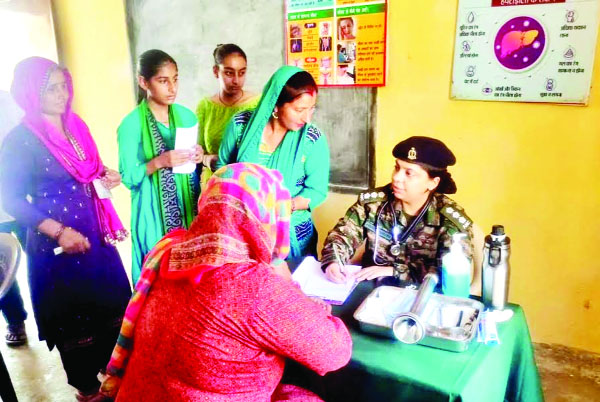DOGRA HERALD BUREAU
Akhnoor, June 19
In a commendable initiative, the Indian Army, in collaboration with various government departments, organized a ‘Jan Jagrukta Shivir’ at the border village of Kaleeth in Akhnoor. The primary objective of this camp was to educate and inform the residents about various government schemes and to facilitate direct interaction between the villagers and government officials. This initiative aimed to bridge the information gap and ensure that the benefits of government schemes reach the grassroots level.
The ‘Jan Jagrukta Shivir’ saw active participation from residents who were keen to learn about the various welfare schemes available to them. The camp provided a unique platform for face-to-face interaction, allowing villagers to register for multiple schemes directly. Representatives from several key sectors, including Social Welfare, Agriculture, Horticulture, Animal Husbandry, Health, and Banking, were present to engage with the community.
The interaction was fruitful, with government representatives educating the residents about the specifics of various schemes tailored for individuals of all genders and age groups. For many villagers, this was the first time they received detailed information about these programs, which significantly impacted their awareness and understanding.
In the Social Welfare sector, officials provided information on schemes aimed at supporting vulnerable sections of the society, including the elderly, women, and children. They discussed various pension schemes, financial assistance programs, and educational scholarships designed to uplift the economically weaker sections of the community.
Agriculture and Horticulture representatives highlighted schemes focused on enhancing agricultural productivity and supporting farmers. They introduced the villagers to modern farming techniques, subsidies for seeds and fertilizers, and financial assistance for setting up horticultural ventures. This information was particularly valuable for the residents of Kaleeth, a village with a significant number of farming families.
The Animal Husbandry department provided insights into schemes supporting livestock management, veterinary services, and dairy farming. They emphasized the importance of animal health and productivity in improving the economic conditions of rural households. Health sector officials discussed various health schemes, including those related to maternal and child health, immunization programs, and health insurance plans. They also provided on-the-spot health check-ups and distributed informational pamphlets on maintaining good health practices.
The Banking sector played a crucial role in informing the villagers about financial inclusion schemes. Representatives explained the benefits of having a bank account, various savings schemes, and how to avail loans for agricultural and personal development purposes. This was instrumental in promoting financial literacy among the rural population. The active engagement of government agencies with the residents ensured that a large number of locals registered for welfare schemes which they were previously unaware of. This direct approach not only enhanced the villagers’ knowledge but also empowered them to take advantage of the benefits provided by the government.
The ‘Jan Jagrukta Shivir’ organized by the Indian Army and government departments at Kaleeth, Akhnoor, was a significant step towards bridging the information gap between the government and the rural population. It demonstrated the Army’s commitment to community welfare and its role in fostering a more informed and empowered society. The success of this initiative paves the way for similar camps in other border villages, ensuring that the benefits of government schemes reach the remotest parts of the country.
In conclusion, the ‘Jan Jagrukta Shivir’ was a highly impactful event that brought government schemes to the doorstep of the villagers in Kaleeth. The initiative not only educated the residents but also facilitated their registration for various welfare programs, thereby enhancing their quality of life and contributing to the overall development of the community.



























